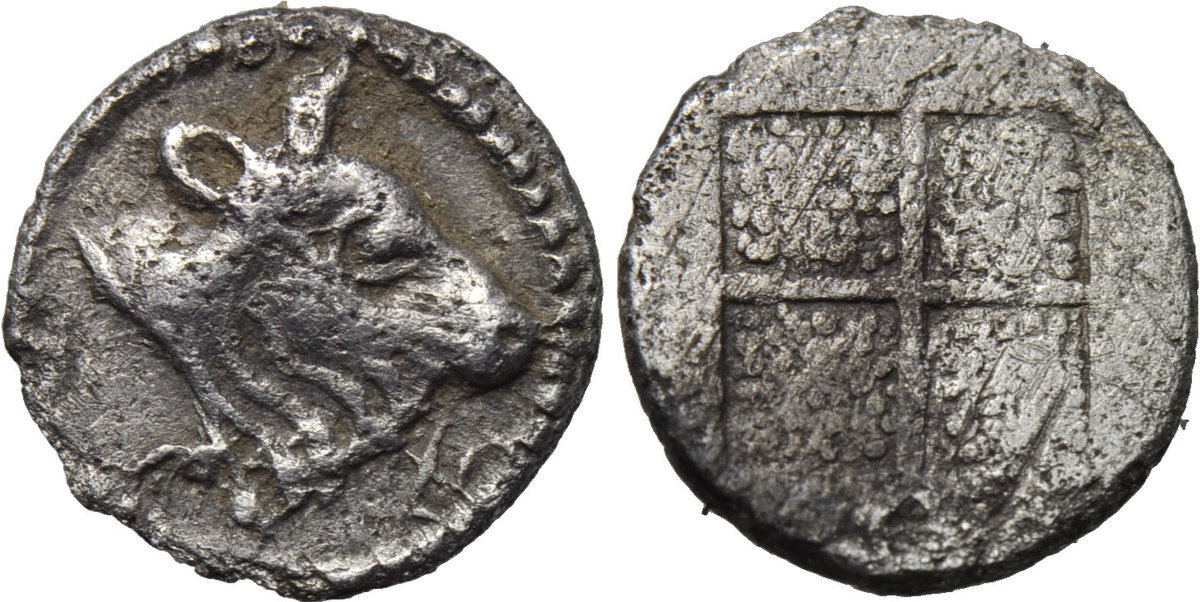S 1823 - Acanthus, silver, tritetartemoria (Period F) (430-380 BCE)
From SILVER
430 BCE - 380 BCE Silver 377 kg
Description
| ObverseInscription or printing placed on the obverse.: | Head of bull right |
| ReverseInscription or printing placed on the reverse.: | Head of bull right Quadripartite incuse square |
Mint and issuing power
| MintIdentifies the place of manufacture or issue of a numismatic object.: | Acanthus | Ancient regionAncient region.: | Macedon | Modern countryModern country: Greece | AuthorityIdentifies the issuing power. The authority can be "pretended" when the name or the portrait of X is on the coin but he/she was not the issuing power. It can also be "uncertain" when there is no mention of X on the coin but he/she was the issuing power according to the historical sources: |
Chronology
| FromIdentifies the initial date in a range assigned in a numismatic context. | 430 BCE | toIdentifies the final date in a range assigned in a numismatic context.. | 380 BCE | PeriodTime period of the numismatic object.: Classical 480-323 BC |
Physical description
| MetalThe physical material (usually metal) from which an object is made.: | Silver |
Median weightMedian of the weights of numismatic objects (in grams). in grams | 0.40 | DenominationTerm indicating the value of a numismatic object. Examples: tetradrachm, chalkous, denarius.: | tritetartemorion | StandardStandard.: |
Image

S1823 Acanthus tritetartemoria F.jpg [1]
References
| Die study referencePublication of the study: | Tselekas 19961Tselekas 1996, p. 300-304 | ||
| Coin series referenceReference to coin series study: | |||
Obverse dies distribution
| FrequencyFrequency of specimen in distribution. ᵖ | Number of obversesNumber of obverse dies. ᵖ (o) | % (o) | Number of coinsNumber of coins. (n) | % (n) | Die nameName(s) of the die(s). |
| 1 | 21 | 72.41 | 21 | 36.21 | 99, 100, 101, 102, 103, 104, 105, 106, 107, 112, 113, 114, 115, 117, 118, 119, 121, 122, 123, 124, 125 |
| 2 | 3 | 10.34 | 6 | 10.34 | 98, 111, 126 |
| 3 | 1 | 3.45 | 3 | 5.17 | 110 |
| 4 | 1 | 3.45 | 4 | 6.9 | 108 |
| 6 | 1 | 3.45 | 6 | 10.34 | 116 |
| 8 | 1 | 3.45 | 8 | 13.79 | 120 |
| 10 | 1 | 3.45 | 10 | 17.24 | 109 |
| Total | 29 of 29 | 100 | 58 of 58 | 99.99 |
Reverse dies distribution
no distribution is available
Quantification
| Number of obversesNumber of obverse dies. ᵖ (o) | 29 | Number of singletons (o1)The number of singleton coins. ᵖ | 21 |
| Number of reverse diesNumber of reverse dies. (r) | 33 | Number of coinsNumber of coins. (n) | 58 |
| Coins per obverse dieNumber of coins per obverse die. (n/o) | 2 | Coins per reverse dieNumber of coins per reverse die. (n/r) | 1.76 |
| Reverse per obverse ratioRatio of obverse dies divided by reverse dies. (r/o) | 1.14 | Percentage of singletons (o1)number of coins (n) divided by the number of singletons (o1) ᵖ | 72.41 % |
| Original number of dies (O) (Carter 1983 formula)The estimation of the number of coins according to Carter 1983 ᵖ | 47.08 | Coins struck if 20,000 as average productivity per dieCoins made if the average productivity for obverses (according to Carter) is 20,000. ᵖ | 941,600 |
| Original number of dies (O) (Esty 2011 formula)The estimation of the number of coins according to the singleton formula in Esty 2011 ᵖ (O) | 58 | Survival rate if 20,000 as average productivity per dieSurvival rate if average productivity is 20,000. ᵖ | 0.00006 |
| Coverage (o = % of O) (Esty 1984 formula)Esty 1984 - coverage (% of O) ᵖ (o = % of O) | 63.79% | Die productivity if survival rate 1/2,000Average productivity if survival rate is 1/2,000. ᵖ | 2,463.89 |
| Weight of silver (in kg) if 20,000 coins per die (O = Carter formula)Carter 1983 * Median weight * 20000 (*10 if gold or electrum) ᵖ | 377 kg <br /> 377 kg | Die productivity if survival rate 1/5,000Average productivity if survival rate is 1/5,000. ᵖ | 6,159.73 |
Remarks
Most likely one single workstation
References
- ^ Tselekas, Panagiotis (1996), The Coinage of Acanthus, Oxford, St Cross College, DPhil, 350 p., 7 maps, 53 pl.